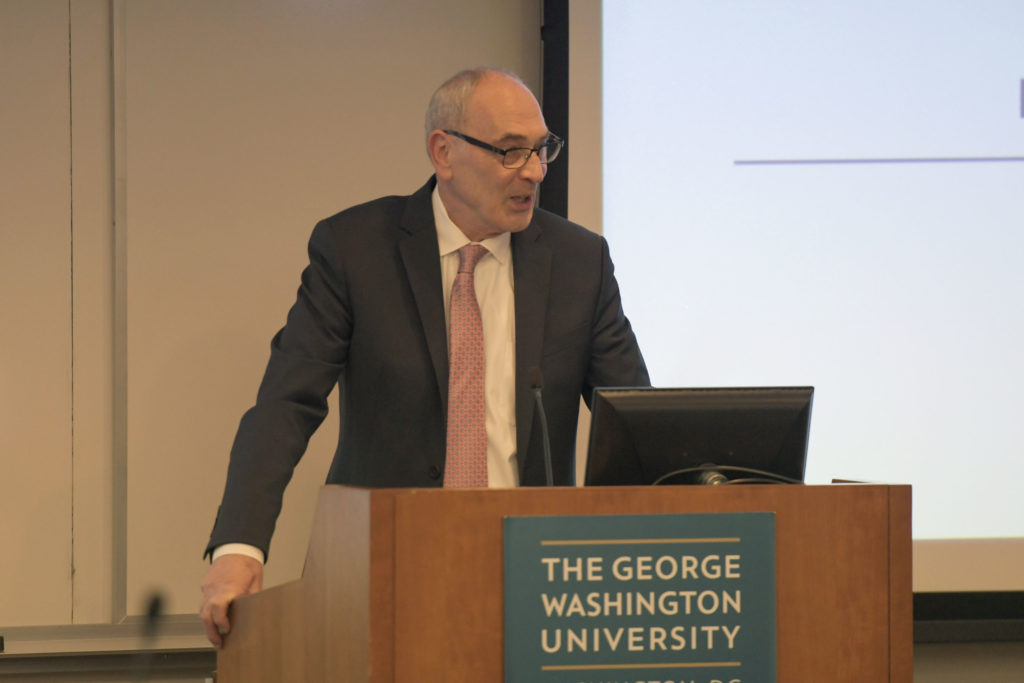Updated: May 15, 2019 at 11:23 p.m.
After one academic year as vice president for research, Robert Miller said he has taken steps to enhance GW’s reputation as a research institution.
During the first year of his tenure, Miller increased funding for research on new medical therapies, helped launch a research office for postdoctoral students and oversaw a review of the University’s research environment. Officials and research experts said Miller should continually reassess the strengths and weaknesses of the research department to determine which components of the research system need to be improved moving forward.
“My goals over the last ten months have largely revolved around the strategic alignment of the research and academic missions, operational enhancements and improvements to the research experience for undergraduates, graduate students, postdocs and faculty,” Miller said in an email.
Miller said he consulted with Provost Forrest Maltzman, University President Thomas LeBlanc, trustees and other “key stakeholders” and “advisory committees” to set GW’s research goals. He said instituting the recommendations in April’s research ecosystem report complements GW’s “action plan” to improve University research processes.
“To move a number of strategic goals forward, we utilized the faculty-led research ecosystem review to collect input from the GW research community,” he said. “The ecosystem review itself was a major goal of the University’s strategic initiative and an important first step toward addressing a number of priorities.”
LeBlanc’s strategic initiative to boost GW’s research profile focuses on expanding research opportunities for students, reviewing the University’s research environment and increasing support for principal investigators.
Miller said officials launched an electronic system to track compliance with University and federal research regulations this year. He said a new second system to be launched will streamline grant proposal procedures and manage pre-award and post-award processes.
“The potential efficiencies and transparency created by a new tool will address some of the concerns we’re hearing from researchers and research administrators,” Miller said.
Miller said last year’s “realignment” of the Office of the Vice President for Research under the Office of the Provost has strengthened undergraduate research “experiences” and non-sponsored research and scholarship. Miller’s position, which previously reported to LeBlanc, switched to report to the provost last summer.
“I am pleased to say that the Office of the Provost and the Office of the Vice President for Research have developed a much stronger working relationship than they have ever had,” he said.
He added that the University, with the support of the provost and the University president, has increased funding for internal research programs and broadened access to internal funding to more faculty members. Miller said allocating more funding to internal research programs will help researchers receive external funding for their projects or launch interdisciplinary research programs.
“These early investments by the University can pay large dividends when funded teams go on to win large external grants or launch self-sustaining interdisciplinary research programs,” he said.
Miller announced in January that the University will increase funding for research on new medical therapies and procedures.
He said the second phase of the University research ecosystem review will find ways to increase support for postdoctoral students, augment usage of shared research facilities, increase investment in high-performance computing infrastructure and ensure that resources are equitably allocated to researchers. The second phase’s results will be released in 2020.
Miller added that he plans to continue working with the Office of the Provost and the Office of the President to offer more research opportunities to undergraduate students, like adding “enhancements” to Research Days and increasing interdisciplinary research efforts.
“A number of goals are ongoing and reflect the need for multi-year planning or effort and a long-term perspective,” he said.
Research experts said vice presidents for research should continually observe which components of a research system are effective at their own university and other schools and annually consult with officials to set priorities for improving the school’s research environment.
Peter Dorhout, the vice president for research at Kansas State University, said officials should calculate the success of a vice president for research based on whether the individual meets the goals set earlier in the academic year. He said the vice president for research should consult with university leadership to determine what aspects of the research environment need to be improved.
“They should be evaluated with whatever they were told they were going to be evaluated with at the beginning of their term,” Dorhout said. “It’s what the president or chancellor of the university has in mind for their performance expectations for the VPR.”
Edward Hackett, the vice provost for research at Brandeis University, said vice presidents for research should regularly reassess the strengths and weaknesses of a university’s research environment.
“It’s a mixture of being responsive to the needs of the university and faculty and students there, and being foresightful,” Hackett said. “How much of the old do you want to continue, how much of what’s new do you want to start?”
Ed Prestera contributed reporting.
This post was updated to reflect the following correction:
The Hatchet incorrectly reported that Forrest Maltzman is the former provost. Maltzman announced his resignation but will not step down until a new provost is hired. We regret this error.




